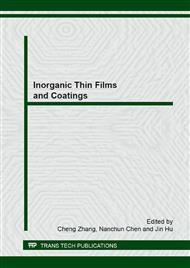[1]
Information on http://blog.sina.com.cn/nonferrousme
Google Scholar
[2]
M.H. Harati, J. Jia, K. Giffard, K. Pellarin, C. Hewson, A.L. David, W.M. Lau and Z.F. Ding, One-pot electrodeposition, characterization and photoactivity of stoichiometric copper indium gallium diselenide(CIGS) thin films for solar cells, Chem. Phys. 12 (2010) 15282-15290.
DOI: 10.1039/c0cp00586j
Google Scholar
[3]
B.N. Illy, A.C. Cruickshank, S. Schumann, et al., Electrodeposition of ZnO layers for photovoltaic applications: controlling film thickness and orientation.J. Mater. Chem. 12 (2011) 12949.
DOI: 10.1039/c1jm11225b
Google Scholar
[4]
T. Minemoto, T. Matsui, H. Takakura, et al, Theoretical Analysis of the Effect of Conduction Band Offset of Window/CIS Layers on Performance of CIS Solar Cells Using Device Simulation. Solar Energy Materials & Solar Cells. 67 (2001) 83-88.
DOI: 10.1016/s0927-0248(00)00266-x
Google Scholar
[5]
Y.M. Xue, Y. Sun, F.Y. Li, et al., Research on the Structure of the Heterojunction of the CIGS Thin Film Soler Cells. Journal of synthetic crystals. 33 (2004) 841-842.
Google Scholar
[6]
H.M. Wei, H.B. Gong, Y.Z. Wang, X.L. Hu, L. Chen, H.Y. Xu, P. Liu and B.Q. Cao, Three kinds of Cu2O/ZnO heterostructure solar cells fabricated with electrochemical deposition and their structure-related photovoltaic properties, Cryst Eng Comm. 13 (2001) 6065.
DOI: 10.1039/c1ce05540b
Google Scholar
[7]
C. Frederik, L. Colin, L. Neil, Y.S. Allan, N. R. Michael and H. John, Growth of ZnO thin films-experiment and theory. J. Mater. Chem. 15 (2005) 139.
Google Scholar
[8]
Z.K. Tang, G. Wang, K. Liu, et al, Room-temperature ultraviolet laser emission from self-assembled ZnO micro crystallite thin film. Appl. Phys. Letts. 72 (1998) 3270-3272.
DOI: 10.1063/1.121620
Google Scholar
[9]
H.J. Hang, Y.F. Chen, S.K. Hong, MBE Growth of Gigh-Quality ZnO Films. Journal of Crystal Growth. 209 (200) 816-821.
Google Scholar
[10]
A.C. Rastogi, S.B. Desu, P.B. Hattacharya, R.S. Katiyar, Effect of starin Gradient on Luminescence and Electronic Properties of Pulseed Laser Deposited Zinc Oxide Thin Films.J. Electronceram. 13(2004) 345-352.
DOI: 10.1007/s10832-004-5124-9
Google Scholar
[11]
D. Calestani, M. Z. Zha, L. Zanotti, M. Villani and A. Zappettini, Low temperature thermal evaporation growth of aligned ZnO nanorods on ZnO film: a growth mechanism promoted by Zn nanoclusters on polar surface, CrystEngComm. 13 (2011) 1707-1712.
DOI: 10.1039/c0ce00670j
Google Scholar
[12]
K.J. Omichi, N.K. Takahashi, T.K. Nakamura, et al., AP-HVPE growth of ZnO with room-temperature ultraviolet emission Journal of materials, 11 (2001) 3158-3160.
Google Scholar
[13]
K.J. Omichi, K.Z. Kaiya, N.K. Takahashi, et al., Growth of ZnO thin films exhibiting room- temperature ultraviolet emission by means of atmospheric pressure vapor-phase epitaxy. J. Mater. Chem. 11 (2001) 262-263.
DOI: 10.1039/b006656g
Google Scholar
[14]
B.D. Cullity, S. Rstock, Elements of X-ray Diffraction, Prentice Hall, New Jersey,2001.
Google Scholar
[15]
O. Lupan, T. Pauporte, L. Chow, B. Viana, F. Pelle, L.K. Ono, B. Roldan Cuenya, H. Heinrich, Effects of annealing on properties of ZnO thin films prepared by electrochemical deposition in chloride medium.Applied Surface Science.256 (2010) 1895-1907.
DOI: 10.1016/j.apsusc.2009.10.032
Google Scholar
[16]
J. B. Franklin, B. Zou, P. Petrov, D. W. McComb, M. P. Ryan and M. A. McLachlan. Optimised pulsed laser deposition of ZnO thin films on transparent conducting substrate. J. Mater. Chem. 21 (2011) 8178.
DOI: 10.1039/c1jm10658a
Google Scholar


